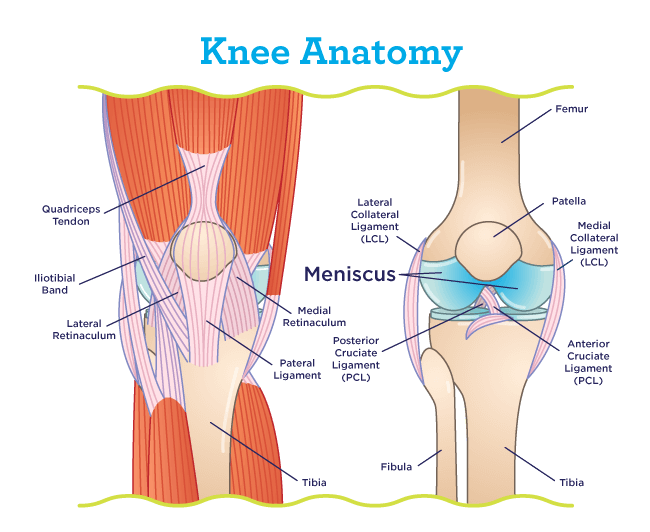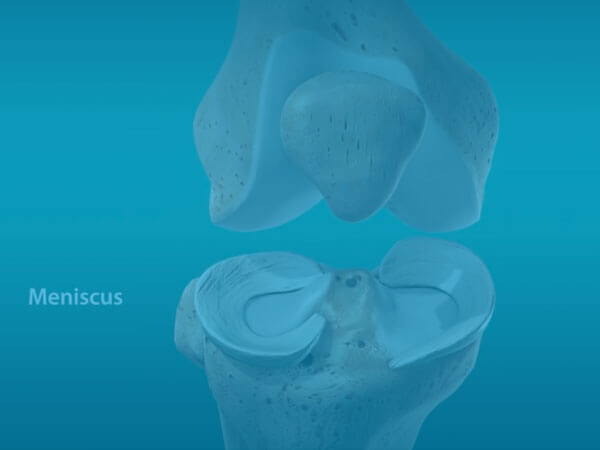02/10/2022
The meniscus is a c-shaped piece of cartilage located in the knee. Its purpose is to provide shock absorption and help stabilize the knee during activity. Tears occur most often from pivoting or from sudden stops and turns. Keep in mind that movements as simple as kneeling or squatting, especially when lifting heavy objects, can lead to a meniscus tear.
What are the different types of meniscus tears?
There are six types of Meniscus tears. However, it is possible to have one or a combination of tears:
Radial Tear
A common type of meniscus tear, radial tears occur where there is no blood supply, which prevents the tear from healing on its own.
Oblique/Flap Tear
These tears often have an irregular pattern and cause symptoms of “catching” in the knee. Usually, the flap can be removed as part of the treatment plan.
Peripheral Tear
This type of tear is more typical with an associated anterior cruciate ligament (ACL) injury. Peripheral tears are in the most vascular portion of the meniscus, which aids in the healing process.
Bucket-Handle Tear
Typically, this type of tear prevents normal knee motion and requires more urgent surgical treatment to regain full range of motion. Bucket-handle tears are a particular type of peripheral tear.
Horizontal Tear
This tear is often considered to be more degenerative in nature. Most horizontal tears are treated with partial meniscectomy although as they get closer to the blood supply one could consider repair.
Root Tear
This tear involves “bad actors” occurring where the meniscus attaches to the bone, root tears often lead to higher levels of pain, instability and, longer-term, can lead to a faster development of osteoarthritis.
What questions are typically asked during an examination for knee pain?
- What symptoms (pain, swelling, catching, limited motion) are you experiencing?
- When did your symptoms begin?
- Can you pinpoint the area of the knee the pain is coming from?
- What activities or motions aggravate your symptoms?
What does a physical examination of knee pain include?
- Evaluate for effusion (fluid): The surgeon or other provider will look for any fluid retention in the injured knee.
- Measure range of motion: By gentle bending of the knee, we can identify if range of motion is limited due to the injury.
- Assess stability: through a series of tests, more information can be gathered regarding any red flags indicating possible further damage to your ACL/PCL or MCL/LCL.
- Evaluate the meniscus: specifically to pinpoint the type of tear through a series of tests.
What are the treatment options for a meniscus tear?
The treatment plan for a meniscus tear is dependent on the location of the tear, its severity, the age of the patient and a range of other factors. The plan could include an operative treatment (surgical) or a conservative treatment (injection).
What kinds of surgical treatment might be recommended?
- Meniscal Repair: recommended when the tear is fairly simple in nature, close to blood supply (for example, a peripheral tear), it stems from an acute injury and the patient is younger.
- Partial Meniscectomy: The most common form of knee surgery performed, it is recommended for an injury when there are significant mechanical symptoms, those tears far away from the blood supply (radial tears, horizontal tears), older patients, or when a conservative treatment has failed.
With multiple factors to consider, an experienced orthopedic surgeon can help walk you through your best option. Both treatments are typically performed by knee arthroscopy using minimally invasive techniques, and you would go home the same day.
Who is more likely to be recommended a conservative treatment over surgery?
Conservative treatments are recommended when a patient does not meet the criteria for a meniscus repair. Factors could include: no effusion (excessive fluid), older patients, complex tear types, no mechanical symptoms and those instances when the primary symptom is knee pain.
What does a Conservative Treatment include?
- Oral Analgesics: these treatments relieve pain and can include acetaminophen, NSAIDs or COX-2 inhibitors.
- Physical Therapy/Home Exercises: treatment could include aquatic therapy or gentle exercises to minimize loading and improve the mechanics/biomechanics of the knee.
- Injections: relieve knee pain and inflammation and can include corticosteroid (most common) or viscosupplementation (hyaluronic acid). Orthobiologics (platelet-rich plasma or “stem cells”) have recently garnered a lot of attention in the media but are generally considered “experimental” by most insurance carriers and are typically not covered.
When are Knee Injections recommended?
Knee injections are recommended when other conservative treatment options are no longer providing relief. Once a patient is experiencing severe pain, constant symptoms and a series of other criteria, an injection will likely be recommended if corrective surgery is not in order to relieve pain and other symptoms.
Suspecting a meniscus tear or other knee injury? Ask your question via text at (402) 609-3000, Request an Appointment, or call (402) 609-3000.






